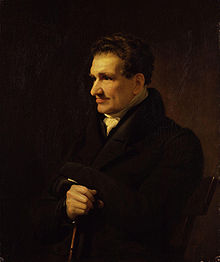James Heath (engraver)
| James Heath | |
|---|---|

Portrait of James Heath by James Lonsdale, 1830
|
|
| Born |
James Heath 19 April 1757 London, England |
| Died | 15 November 1834 (aged 77) London, England |
| Nationality | English |
| Known for | Engraver |
James Heath (19 April 1757 – 15 November 1834) was an English engraver. He enjoyed the patronage of George III and successive monarchs, and was an associate engraver of the Royal Academy.
Heath was born in Newgate, London, the son of George Heath, a bookbinder (d. 1773). He was articled to the engraver Joseph Collyer the younger, an exacting master who required steady application from his pupil - as a result, Heath acquired a great mechanical skill in his art. His earliest engravings were of portraits in the collected edition of Horace Walpole's works. He was subsequently employed to engrave Thomas Stothard's designs for Harrison's "The Novelist's Magazine" and Bell's "Poets of Great Britain", and the taste and dexterity with which he rendered these small illustrations brought this style of illustration into great popularity. He made many engravings after artists such as Stothard, Smirke, and others, and these were to be found in publications such as: Sharpe's "British Classics", the "Lady's Poetical Magazine", Forster's "Arabian Nights", Glover's "Leonidas", and many similar editions of popular works.
He engraved some of the plates for John Boydell's "Shakespeare" and also, in 1802, published his own six-volume illustrated edition of Shakespeare. In 1780, he exhibited three engravings at the exhibition of the Society of Artists. In 1791, he was elected an associate engraver of the Royal Academy, and, in 1794, was appointed historical engraver to George III, continuing in that post under successive sovereigns until his death. He engraved some large plates, notably "The Dead Soldier" (after Joseph Wright of Derby), "The Death of Nelson" (after Benjamin West), "The Riots in Broad Street. 1780" (after Francis Wheatley, "The Death of Major Pierson" (after J S Copley), "Titian's daughter" (after Titian),"The Holy Family" and "The Good Shepherd" (after Murillo), "The Holy family" (after Raphael) etc.
...
Wikipedia
